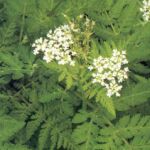| Common Name: |
Caraway |
| Botanical Name: |
Carum carvi |
| Genus: |
Carum |
| Family: |
Apiaceae |
| Native Location: |
Europe, Western Asia, Germany, Holland, Russia, Scandinavia, United States |
| Cultivation: |
Well-drained, fertile soil in full sun. Caraway tolerates heavy soils. Flowers attract parasitic wasps, which prey on aphids. |
| Propagation: |
By seed sown in situ in spring or early autumn. Does not transplant well. Self-seeds in suitable conditions. |
| Harvest: |
Leaves and roots are gathered to be used fresh as vegetables. Seeds are gathered as they ripen and are dried for use in infusions, pills, and tinctures. Oil is distilled commercially for flavoring and pharmaceutical products. |
| Height: |
60-90cm (2-3ft) |
| Width: |
30cm (12in) |
| Hardiness: |
Z3-9 |
| Extraction: |
Steam Distillation |
| Parts Used: |
Leaves, roots, seeds, oil |
| Color and Odor: |
The essential oil is pale yellow in color and has a sweet, sharp, slightly spicy aroma. |
| Background: |
Know to the ancient Egyptians, Greeks, and Romans. The seeds are popular in Arab and Northern European countries as a flavoring in baking and pastries, especially in rye breads. Caraway is also a main ingredient of the German Liqueur, "Kummel". |
| Properties: |
Carminative, digestive, diuretic, antispasmodic, antiseptic, stimulant and tonic.
A pungently aromatic, stimulant herb that reduces gastrointestinal and uterine spasms, and encourages productive coughing. |
| Planet: |
Mercury. |
| Element: |
Air. |
| Magical Influences: |
Conscious mind, Physical energy, Love. |
| Medicinal Uses: |
Internally for indigestion, gas, colic (especially in children), hiatus hernia, stomach ulcer, diarrhea, menstrual cramps, and bronchitis. Externally as a gargle for laryngitis. Added to laxatives to reduce griping and to various products for digestive problems. Seeds are chewed for relief of indigestion. |
| Uses: |
- Digestive Sytem—Tonic to the digestive tract. Helps with indigestion by stimulating the intestinal walls and easing spasms caused by flatulence.
- Urinary System—Promotes the flow of urine and encourages the flushing of toxins.
- Reproductive Sytem—Promotes menstruation and also lactation.
- Skin—Effective in tissue regeneration, helping with bruises. Also useful for skin problems such as acne, boils, and scabies.
- Emotions—Stimulating and refreshing to the mind, caraway enhances alertness and strengthens the memory. It eases mental strain and fatigue, replenishing lost energy.
|
| Blends: |
| DIGESTIVE |
URINARY |
REPRODUCTIVE |
| Caraway 6 |
Caraway 6 |
Caraway 5 |
| Black Pepper 4 |
Juniper 4 |
Fennel 3 |
| Ginger 2 |
Rosemary 3 |
Rosemary 2 |
|
| SKIN |
EMOTION |
| Caraway 5 |
Caraway 5 |
| Chamomile (R) 4 |
Palmarose 4 |
| lemon 3 |
Basil 3 |
| Culinary Uses: |
Leaves have a mild parsley-dill flavor, pleasant in soups and salads. Roots may be cooked as a vegetable. Seeds are especially popular in Jewish cuisine and in the cuisines of N and E Europe, flavoring cakes and bread (notably rye bread), goulash, cabbage, sauerkraut, sausages, cheese, cooked apples, liqueur (such as kümmel), and spirits (schnapps); also sugar-coated as "sugar plums". |
| Economic Uses: |
Oil is used in perfumery and for flavoring ice cream, candy, pickles, and soft drinks. |
| Bibliography: |
Aromatherapy Blends and recipes by Franzesca Watson Copyright © 1995 Thorsons, Harper Parker Publishing Inc. Pp 72-73
Magical Aromatherapy by Scott Cunningham Copyright © 1989 Llewellyn Publications, Inc. Pg 67
Encyclopedia of Herbs by Deni Brown Copyright © 1995, 2001 Dorling Kindersley Limited. pg 157 |
|

